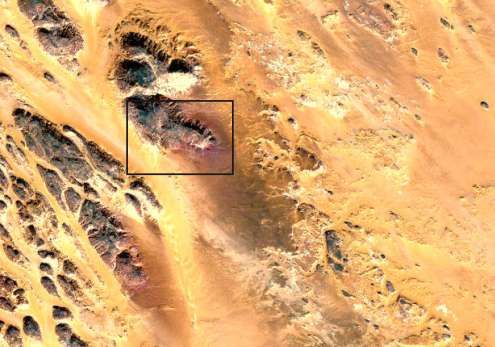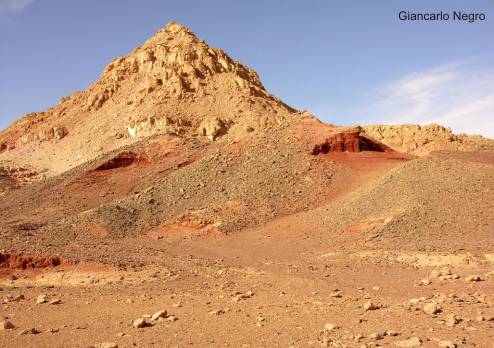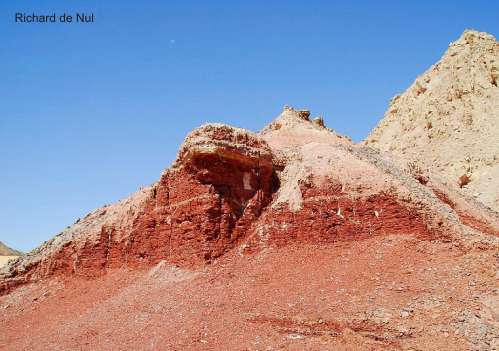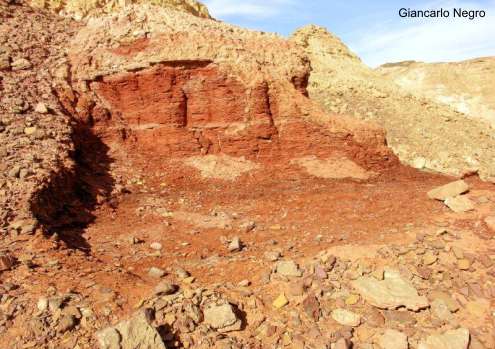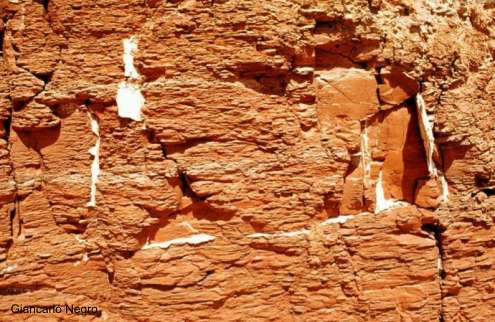|
The geological position of the layers in the pharaonic
"Ochre Quarries"
at the Abu Ballas Trail (Western Desert, Egypt)
|
December 2010
Norbert Brügge,
Germany
Dipl.-Geol.
On the route between Abu Ballas -- a depot of water
jugs, built in the Pharaonic period -- and the Gilf Kebir plateau, excavated
outcrops of red Ochre layers from the Abu Ballas Formation were described.
This specially locality were found and photographed in February 2003
by Giancarlo Negro, Italia. In November 2005, have precise explored
Giancarlo Negro, Vincenzo de Michele and Benito Piacenza this locality. They
come to the conclusion that the Ochre layers was used by mining in the Pharaonic
period. The results were published in Sahara Journal 2005 and
2007. During an expedition to the Gilf Kebir in 2009 explored
Richard de Nul, Belgium,
and its companions, the "Ochre Quarries" again.
The geological context of the Ochre layers
In connection with the Ochre layers
was mentioned the Abu Ballas Formation. This Formation in the Western
Desert of Egypt represents a marine intercalation within fluvial, Nubia-type
sandstones. These deposits document an extensive transgression of Aptian age
flooding the Dakhla Basin from north to south. Due to this first advance of
the Tethyan sea during the Cretaceous, sediments of open and marginal marine
provenance were accumulated in the SE of the basin.
At the western coast line the Abu Ballas Formation is interfinger with the
fluvial Gilf Kebir
Formation.
The sedimentary succession of the open marine facies is in sense HENDRIKS
& KALLENBACH (1986) divided into five lithostratigraphic units which reflect
that deposition was largely controlled by one single transgressive-regressive
event. The transgressive sequence in the lower part of the formation comprises
sandstones of a backshore to foreshore environment (unit 1) which are overlain
by offshore claystones (unit 2). The middle portion of the sedimentary succession
consists of silty and sandy strata (unit 3) which are attributed to large-scale
redepositional processes due to intensified bottom currents during the maximum
extension of the sea. These sediments are capped by off-shore originated claystones
(unit 4) grading upwards into siltstones and sandstones of transition-zone
to backshore environments (unit 5), which indicate a gradual regression. This
stratigraphic sequence documenting a retrograding-prograding shoreline due
to the transgression and regression of the Aptian sea, interfingers with silty
and sandy deposits of the marginal marine facies of the Abu Ballas Formation.
Comparable to the lithostratigraphic units 1 and 5 these strata represent
a variety of sedimentary environments ranging from the backshore to the transition
zone. They were accumulated on the western slope of the Kharga Uplift bounding
the Dakhla Basin towards the east, which was partially flooded while the sea
had its maximum extension.

|
The stratigraphic sequence
of open marine origin which has a thickness of 12.2 m to 27.6 m, is
separated into the following 5 units because of lithologic aspects.
Unit 1
The strata of unit 1 comprise white and grey, fine-grained sandstones
which are strongly bioturbated. These deposits overlying the Six Hills
Formation with a gentle unconformity, where they attain a thickness
of 1.5 m. This sequence generally is small-scale wave-ripple cross-laminated.
The foreset laminae are more less bundled. Individual sets which often
have an undalatory lower bounding surface, and cosets partially are
separated by evenly laminated beds with a thickness of 2-5 cm. These
occasionally show desiccation cracks and are bare of any trace fossils.
The uppermost part of the unit is destratified due to intense bioturbation.
Unit 2
Unit 2 mainly consists of white, grey, green, red and violet, partially
mottled, massive or laminated claystones. The thickness of this unit
varies from 1.8 m to more than 7.0 m. These strata are bioturbated and
contain shells of brachiopods (Lingula sp.), pelecypods and gastropods.
The middle part of the unit is made up of white and yellowish grey,
laminated, fossiliferous, marly claystones. Locally the uppermost portion
of the sequence is characterized by an increasing silt and sand content
documenting a gradual coarsening upwards of grain sizes. Lenses and
beds of fine-grained sandstone which are horizontally bedded or small-scale
wave- and current-ripple cross-laminated, also occasionally occur in
this part of unit 2. These intercalations attain a thickness of 2 to
10 cm. The partially calcareous sandstone beds contain bioturbations,
among which Rhizocorallium sp. The upper part of this unit is furthermore
characterized by the occurrence of concretionary clay-ironstone layers
and of coquinas which are up to 5 cm thick and occassionally contain
intraformational claystone pebbles.
Unit 3
The deposits of unit 3 comprise siltstones and sandstones which have
a thickness of 1.0 to 2.3 m . Yellowish grey and red, horizontally bedded
siltstones with trace fossils varying in thickness from 1.0 to 2.2 m.
These strata often are clayey and partially contain claystone layers.
The siltstones occasionally are calcareous again. They alternate with
bioturbated, fine-grained sandstone beds, which show small-scale wave-ripple
cross-lamination and which are up to 10 cm thick. The uppermost 0.1
m of unit 3 within this section consists of an intraformational conglomerate
overlying a minor erosional unconformity. This unit is almost completely
made up of red and violet, bioturbated, fine-grained sandstones. These
sediments which attain a maximum thickness of 2.1 m are small-scale
current- and wave-ripple cross-laminated. In the latter section they
overlie a grey, massive siltstone bed with a thickness of 0.2 m.
Unit 4
The strata of unit 4 again are made up of grey, green, yellowish brown,
red and violet, partially mottled, massive or laminated claystones.
They vary in thickness from 3.4 m to 6.9 m. These sediments contain
various brachiopods, pelecypods, gastropods and trace fossils. In the
uppermost 1.0 to 2.0 m of the unit horizontally bedded siltstone layers
with a thickness of 1-5 cm and intra-formational conglomerates with
a thickness of 5-15 cm occur. The intraformational claystone pebbles
have a maximum diameter of 2.5 cm. A fining-upward sequence with a thickness
of 0.4 m appears in this part of unit 4. It consists of a basal intraformational
conglomerate (10 cm) erosively overlying claystones, which upwards grade
into grey, bioturbated siltstones (15 cm). The latter strata are horizontally
bedded in the lower part and small-scale wave-ripple cross-laminated
in the upper part.
They upwards grade into white, laminated, silty claystones (5 cm) which
in turn are erosively capped by horizontally bedded siltstones (10 cm).
Nearly this entire unit which comprises variegated, massive claystones
with a total thickness of 5.6 m, is destratified by roots penetrating
the sequence from the overlying Sabaya Formation. Only the lowermost
0.5 m of the unit which consists of laminated, silty claystones, is
not uprooted.
Unit 5
The deposits of unit 5 generally are made up of siltstones and sandstones
attaining a thickness of 5.0 to 15.6 m. Although the strata of this
sedimentary succession in all sections studied have more or less the
same lithofacial, stratofacial and ichnofacial characteristics, conspicuous
regional variations occur.
The lower part of the unit 5 comprises grey, bioturbated siltstones
with an upward increasing sand content. Coinciding with the gradual
coarsening of grain sizes, even lamination progressively is replaced
by small-scale current- and wave-ripple cross-lamination. Within these
siltstones numerous grey and red, massive or laminated, thin claystone
layers are intercalated. The upper portion of unit 5 in this section
is made up of grey, reddish brown and violet, fine-to medium-grained
sandstones which are partially strongly bioturbated.
These deposits are mainly evenly laminated or small-scale current- and
wave-ripple cross-laminated. The uppermost part of this sedimentary
succession consists of grouped sets of large-scale cross-bedded psammites
alternating with small-scale current- and wave-ripple cross-laminated
strata, which fill up a local through-shaped depression. The individual
large-scale cross-stratified sets within this sequence have an erosional,
planar or scoop-shaped lower bounding surface. The angular relation
of the lithologically homogeneous, tabular and concave-upward foreset
laminae to the lower bounding surface is discordant.
|
|

Reference profile through the
Abu Ballas Formation
in sense BARTHEL & BOETTCHER, 1978
|

The geographic position of the
"Ochre Quarries": 24�12'48''N / 27�11'28''E
Sources:
W. BARTHEL & R. BÖTTCHER -- Abu Ballas Formation (Tithonian/Berriasian;
Southwestern Desert, Egypt) a significant lithostratigraphic unit of
the former "Nubian Series"
Mitt. Bayr. Staatsslg. Paläontologie hist. Geol., 18, 1978, München,
Germany
Ronald BÖTTCHER -- Die Abu Ballas Formation (Lingula
Shale) (Apt ?) der Nubischen Gruppe Südwest-Ägyptens.
Eine Beschreibung der Formation unter besonderer Berücksichtigung der
Paläontologie
Berliner geowiss. Abh. (A), 39, 1982, Berlin, Germany
Ronald BÖTTCHER -- Environmental model of the
shallow marine Abu Ballas Formation (Aptian, Nubia Group) in South-Western
Egypt
N. Jb. Geol. Paläont. Abh., 196, 3, 1985, Stuttgart, Germany
F. HENDRIKS & H. KALLENBACH -- The offshore
to backshore environments of the Abu Ballas Formation of the SE Dakhla
Basin (Western Desert, Egypt)
Geologische Rundschau 75/2, 1986, Stuttgart, Germany
|
|
|
|




